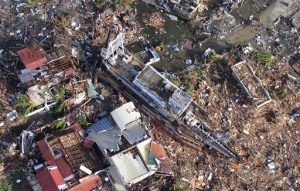Crucial jobs cleaning up after Philippine typhoon

In this aerial photo taken on Saturday, Nov. 9, 2013, and released by the Philippine Air Force, a ferry boat is seen washed inland from a massive storm surge caused by Typhoon Haiyan, in the city of Tacloban, central Philippines. AP FILE PHOTO
TACLOBAN, Philippines – Tens of thousands of desperately needed jobs are being created for survivors of a catastrophic typhoon in the Philippines by paying them to clear mountains of waste from ruined cities and farms.
UN agencies are spearheading the “cash for work” programs, which they hope will provide a triple-boost to communities destroyed by Super Typhoon Haiyan, with lifting morale as vital as cleaning up and helping economies.
“This is not only important to help normalise the economy, but working gives a sense of dignity back in their lives,” said Tim Walsh, leader of the United Nations Development Programme (UNDP) team deployed to the worst-hit city of Tacloban and nearby areas.
The United Nations, working in partnership with the Philippine government, is hoping to create at least 200,000 jobs that could last for up to three years.
Walsh said their immediate task was to help clear the mountains of rotting garbage and debris, which is necessary to allow for faster transport of aid and delivery of other essential services. As much of the material as possible will then be recycled.
Article continues after this advertisementHaiyan, the most powerful typhoon ever recorded to have hit land, slashed across mostly poor central islands of the Philippines regions, killing more than 5,500 people and destroying or damaging the homes of four million.
Article continues after this advertisementGiant storm surges generated by the typhoon were more destructive than the winds, powering more than one kilometre (0.6 miles) inland on the islands of Leyte and Samar.
Dozens of coastal communities were obliterated, as the water crushed homes, fishing boats, vehicles, electrical posts and virtually every other piece of urban infrastructure.
Vast stretches of coastal rice farms were also contaminated and their irrigation channels destroyed, while the wind tore down millions of coconut trees that were a mainstay of the already extremely poor islands.
Leslie Wright, a spokeswoman for the UNDP team in Tacloban, said the cash-for-work programme was similar to an effort in Indonesia’s Aceh region after one of the world’s most devastating tsunamis killed 170,000 people there in 2004.
“Some of the things we are seeing that are comparable to Aceh include the consistency of the debris – like the wood, the metal, rock and concrete, aside from the organic waste and the bodies still being extracted every day,” she said.
The volunteer workers are being paid between 250 and 500 pesos (5-10 dollars) a day to haul the debris to selected collection points, where trucks pick them up to be taken to a temporary landfills outside the city for sorting.
“The wood and timber we can refurbish, which we did in Aceh, where we used them to rebuild schools and houses, while the concrete we used for roads,” Wright said.
“We re-used as much material as we could.”
The UN’s Food and Agriculture Organization is looking to set up a similar cash for work program in agricultural areas, paying farmers and others in the community to clear their land and de-silt irrigation canals.
It said its program will cover more than 150,000 hectares (370,000 acres) and 80 kilometres (50 miles) of communal irrigation canals that need to be cleaned, warning upcoming harvests are at dire risk without quick action.
However the FAO needs more money to get the program into top gear, and this week launched an international appeal for $11 million.
John Lim, the Tacloban city administrator, said having people help in the clearing and rebuilding process was an important way for them to deal with the trauma of the disaster.
“We want to give them a sense of direction, to try and get them back on their feet by giving them an incentive in helping us clean the community,” Lim said.
And for workers such as Rowena Cayuda, a mother of five, there is indeed relief that they no longer have to depend solely on aid to survive, as well as a touch of pride.
“We are doing decent work and we are helping the community,” Cayuda said as she pulled at a rusted metal sheet roofs in Tacloban.
Cayuda said she and her mechanic husband, who lost his job after the auto shop he worked for was destroyed, had initially thought of abandoning the city, but they didn’t have any money to travel.
“Now that we have a little, we think we can start a small business, maybe a store and not leave at all,” Cayuda said